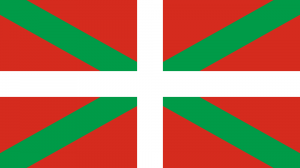Difference between revisions of "Language/Basque/Pronunciation/Alphabet-and-Pronunciation"
| (One intermediate revision by the same user not shown) | |||
| Line 4: | Line 4: | ||
'''Kaixo''', Basque Learners! 😃 | '''Kaixo''', Basque Learners! 😃 | ||
Welcome to the "Basque Alphabet and Pronunciation" lesson! In this lesson, we'll learn about the Basque language, spoken in the Basque Country between Spain and France. The Basque language is unique and doesn't have any known connection to other languages. | |||
We'll start by studying the Basque alphabet, which has 27 letters based on the Latin script. We'll learn each letter's name and pronunciation, and we'll provide English examples to help you understand how they sound. | |||
We'll also talk about some special features of the Basque alphabet, like letters used only in borrowed words or foreign names. Plus, we'll discuss pronunciation rules to help you speak Basque correctly. | |||
This lesson is perfect for anyone interested in languages, planning a trip to the Basque Country, or wanting to connect with their Basque heritage. Let's start learning the Basque alphabet and pronunciation together! | |||
==Alphabet and Pronunciation in Basque== | ==Alphabet and Pronunciation in Basque== | ||
{| class="wikitable" | {| class="wikitable" | ||
| Line 157: | Line 161: | ||
[[Category:Alphabet-and-Pronunciation]] | [[Category:Alphabet-and-Pronunciation]] | ||
<span links></span> | <span links></span> | ||
==Sources== | |||
* https://en.wikipedia.org/wiki/Basque_alphabet | |||
Latest revision as of 23:36, 25 March 2023
Kaixo, Basque Learners! 😃
Welcome to the "Basque Alphabet and Pronunciation" lesson! In this lesson, we'll learn about the Basque language, spoken in the Basque Country between Spain and France. The Basque language is unique and doesn't have any known connection to other languages.
We'll start by studying the Basque alphabet, which has 27 letters based on the Latin script. We'll learn each letter's name and pronunciation, and we'll provide English examples to help you understand how they sound.
We'll also talk about some special features of the Basque alphabet, like letters used only in borrowed words or foreign names. Plus, we'll discuss pronunciation rules to help you speak Basque correctly.
This lesson is perfect for anyone interested in languages, planning a trip to the Basque Country, or wanting to connect with their Basque heritage. Let's start learning the Basque alphabet and pronunciation together!
Alphabet and Pronunciation in Basque[edit | edit source]
| Letter | Basque name | Pronunciation | English Approximant |
|---|---|---|---|
| A | a | /a/ | "ah" |
| B | be | /b/, [β̞] | "bee" |
| C | ze* | /s/, /k/ | "ts" (like in "cats") |
| D | de | /d̪/, [ð̞] | "day" |
| E | e | /e/ | "eh" |
| F | efe | /f/ | "eff" |
| G | ge | /ɡ/, [ɣ̞] | "guh" |
| H | hatxe | ∅, /ɦ/ | "huh" (silent or breathy) |
| I | i | /i/, /i̭/ | "ee" |
| J | jota | /j/, /x/, /ʝ/, /ɟ/ | "yuh" or "huh" (varies) |
| K | ka | /k/ | "kah" |
| L | ele | /l/ | "ell" |
| M | eme | /m/ | "emm" |
| N | ene | /n/ | "enn" |
| Ñ | eñe | /ɲ/ | "en-yay" |
| O | o | /o/ | "oh" |
| P | pe | /p/ | "pay" |
| Q | ku* | /k/ | "koo" |
| R | erre | /r/, /ɾ/ | "rolled r" |
| S | ese | /s̺/ | "ess" |
| T | te | /t̪/ | "tay" |
| U | u | /u/, /u̯/ | "oo" |
| V | uve* | /b/, [β̞] | "vay" |
| W | uve bikoitza* | /u̯/ | "double vay" |
| X | ixa | /ʃ/ | "sh" |
| Y | i grekoa* | /i/, /i̭/, /j/ | "ee" or "yuh" |
| Z | zeta | /s̻/ | "zay" |
Please note that "ze", "ku", "uve", "uve bikoitza", and "i grekoa" are marked with an asterisk (*) because these letters are not part of the traditional Basque alphabet but are used in some loanwords and foreign names.
Videos[edit | edit source]
